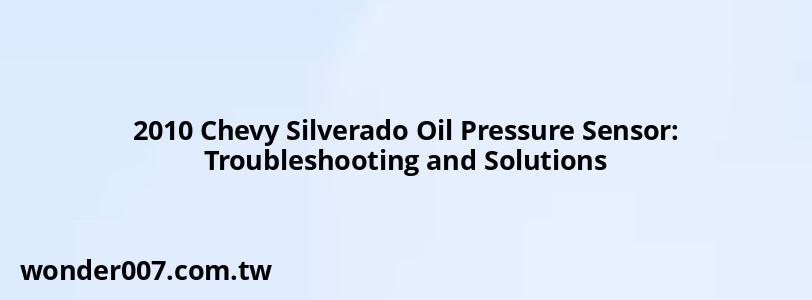2010 Chevy Silverado Oil Pressure Sensor: Troubleshooting and Solutions

The 2010 Chevy Silverado oil pressure sensor is a critical component that monitors oil pressure within the engine, ensuring proper lubrication and operation. Many owners experience issues with this sensor, leading to inaccurate readings or warning lights. This guide will provide an overview of common problems, solutions, and maintenance tips for the oil pressure sensor in the 2010 Chevy Silverado.
Understanding the Oil Pressure Sensor
The oil pressure sensor, also known as the oil pressure sending unit, plays a vital role in monitoring the engine's oil pressure. It alerts the driver through the dashboard gauge when oil pressure falls below a safe level, which can lead to engine damage if not addressed promptly.
Common Issues with the Oil Pressure Sensor
- Inaccurate Readings: Many Silverado owners report that their oil pressure gauge drops to zero intermittently, often accompanied by warning lights. This can occur even when oil levels are adequate.
- Sensor Failure: Over time, the oil pressure sensor can fail due to wear or contamination from dirt and debris. This is particularly common in models from 2007 to 2013.
- Cold Weather Sensitivity: Some users have noted that their sensors fail more frequently during cold weather, leading to erratic gauge behavior.
Diagnosing Oil Pressure Sensor Problems
When diagnosing issues with the oil pressure sensor, consider the following steps:
- Check Oil Levels: Ensure that your engine has sufficient oil and that it is clean. Contaminated or low oil levels can cause incorrect readings.
- Use a Mechanical Gauge: To verify the accuracy of the dashboard gauge, connect a mechanical oil pressure gauge. If the mechanical gauge shows normal pressure while the dashboard gauge reads low, it likely indicates a faulty sensor.
- Error Codes: Check for error codes using an OBD-II scanner. Common codes related to oil pressure issues include P0520, P0521, P0522, P0523, indicating sensor performance problems.
Replacing the Oil Pressure Sensor
If diagnostics point to a faulty oil pressure sensor, replacement is necessary. Here’s how to do it:
1. Gather Tools: You will need a 27 mm deep socket, extensions, and possibly a swivel joint for better access.
2. Disconnect Battery: Always disconnect the negative terminal of the battery before working on electrical components.
3. Remove Engine Cover: If applicable, remove any engine covers to access the sensor located at the back of the engine near the firewall.
4. Replace Sensor:
- Unscrew the old sensor using the deep socket.
- Inspect and replace any filter or screen located beneath it that may be clogged.
- Install the new sensor and torque it to manufacturer specifications (usually around 22-26 ft-lbs).
5. Reconnect Everything: Reattach any connectors or hoses removed during installation and reconnect the battery.
6. Test Drive: Start your vehicle and monitor the oil pressure gauge for proper function.
Maintenance Tips
- Regular Oil Changes: Ensure regular oil changes with high-quality oil to minimize sludge build-up that can affect sensor performance.
- Monitor Temperature Effects: Be aware of how temperature affects your vehicle's performance; consider using synthetic oils that perform better in extreme temperatures.
- Inspect Electrical Connections: Regularly check electrical connections for corrosion or damage that could affect sensor readings.
FAQs About 2010 Chevy Silverado Oil Pressure Sensor
- What causes my oil pressure gauge to drop suddenly?
This could be due to a faulty oil pressure sensor, low oil levels, or issues with the oil pump. - How often should I replace my oil pressure sensor?
While there is no set schedule, replace it if you notice erratic readings or warning lights. - Can I drive my truck if the oil pressure gauge reads zero?
No, driving with low or zero oil pressure can cause severe engine damage.
By understanding how your 2010 Chevy Silverado's oil pressure sensor works and recognizing common issues, you can ensure your vehicle runs smoothly and avoid costly repairs down the line.
Related Posts
-
Rear Differential Replacement for 2001 Chevy Tahoe: A Comprehensive Guide
28-01-2025 • 201 views -
Jeep Cherokee Won't Start: Troubleshooting Guide for 2017 Models
29-01-2025 • 195 views -
Kia Sorento Door Won't Open: Troubleshooting Guide
29-01-2025 • 229 views -
Jeep JK Traction Control Light: Troubleshooting and Solutions
29-01-2025 • 252 views -
Car Battery for 2010 Hyundai Accent: Essential Buying Guide
28-01-2025 • 289 views
Latest Posts
-
How To Turn Off Paddle Shifters Mercedes
01-02-2025 • 414 views -
Are O2 Sensors Covered Under Warranty
01-02-2025 • 398 views -
Rear Brake Caliper Piston Won't Compress
01-02-2025 • 382 views -
2015 Chevy Traverse AC Recharge Port Location
01-02-2025 • 438 views -
Power Steering Fluid Leak On Passenger Side
01-02-2025 • 482 views
Popular Posts
-
Toyota Hiace: Fuel Efficiency Insights for 2025
26-01-2025 • 719 views -
Power Steering and ABS Light On: Causes and Solutions
27-01-2025 • 674 views -
EPC Light: Understanding Causes and Solutions
26-01-2025 • 1098 views -
Hino Warning Lights: Understanding Dashboard Alerts
26-01-2025 • 872 views -
V12 Engine Costs: What You Need to Know
26-01-2025 • 726 views
